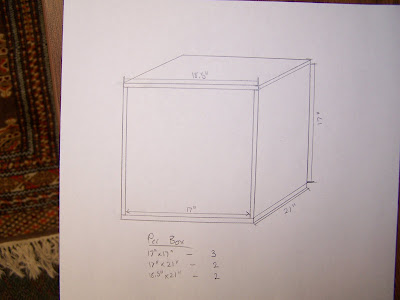
Finally finished (for now).

It's been a while since my last update on the project, since I got on a roll, and just ended up finishing up for now. The first thing I did since last time was to make the holes for the Speakon connectors I'm using. Since the drill bit I was using wasn't quite big enough to make the right size hole for the connector, I had to improvise to get it to fit correctly. First I made a hole in some scrap MDF, and widened it using sandpaper until the connector fit.

Then I used the flush-trim bit for my router and the template hole to cut the perfect size hole for the connector in each cabinet.

These connectors are nice because all of the electrical connections are inside the housing, so there's very little risk of shorting, and they also have a nice locking feature so the plugs won't fall out.

Next I added some bracing across the sides. Eventually I'll be adding some top-bottom bracing, but that probably won't be until I do the wood finishing in a few months. It hardly needs it, but it couldn't hurt.

I don't have any pictures of gluing the top and bottom on, but it was much the same as before. After everything was glued together I used the flush-trim router bit to clean up all the edges before moving onto sanding. Above is a picture of the gasket tape I used around the lip that the driver sits in. It just creates an air-tight seal in the cabinet.

I added a couple screws to the connectors to keep them from moving around. Eventually I'll get some black screws and use some glue on the connectors, but that will wait until after the staining and finishing since I'll have to remove the connectors for that.

I used a roundover bit on the router to clean up the edges a little more. It made a huge difference in the look of the speakers, and it turned out pretty well.

Before finally closing them up, I got some cheap pillows and ripped them open to get some of the polyfill stuffing for the cabinets.

The polyfill increases the apparent internal volume, and should mask some of the mechanical noise from the drivers.

And finally above you can see the finished product. The old subwoofer is in the background, and you can see it's quite a bit smaller. It was tough fitting the new ones in their final places in the small room.

The final assembly wasn't without its challenges. I made the mistake of screwing in the driver before testing all the threads on the hurricane nuts, and it led to some issues. Some of the screws locked up in the nut and actually forced it out of its hole. With the driver in, there was no way for me to hold the nut still so I couldn't remove the screw and the driver was stuck. Eventually I just had to use a hacksaw to cut off the head of the screw and push it through the top so I could remove the driver and install some new hurricane nuts.
And for your viewing pleasure, here are the subwoofers in their natural habitat in my room.


I still need to stain and topcoat the subwoofers, but that can wait, since I don't have any way to safely let the stain dry.
That about wraps it up for now. I'll be posting some frequency response graphs of these monsters in the coming days, so keep a lookout.



















































